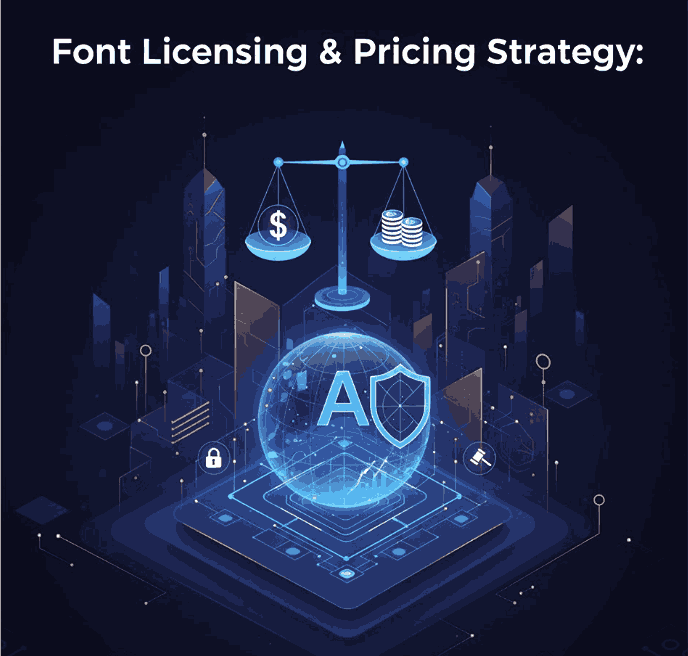Table of Contents
- Introduction: Why Font Licensing Matters
- Understanding Font Licensing Basics
- Types of Font Licenses Designers Should Know
- Setting the Right Font Pricing Strategy
- Factors That Influence Font Pricing
- Common Mistakes to Avoid in Font Licensing
- Case Study: Multi-Style Font Packages and Pricing
- Best Practices for Font Licensing and Marketing
- Conclusion: Building a Sustainable Font Business
- Font Mockup Examples from Edric Studio
- References
1. Introduction: Why Font Licensing & Pricing Strategy Matters
Font Licensing & Pricing Strategy In today’s digital creative economy, Font Licensing & Pricing Strategy are vital topics for designers who sell typefaces online. Fonts are more than design tools—they are intellectual property. Understanding how to properly license and price your fonts determines not only your revenue potential but also how your work is legally protected and perceived in the design market.
As font creators, platforms like Edric Studio play an important role in bridging artistry and business, helping designers sell beautiful and functional fonts to global customers.

2. Understanding Font Licensing & Pricing Strategy Basics
A font license is a legal agreement that defines how customers can use your font. It sets boundaries, such as:
- Personal use – For individuals who use fonts in non-commercial projects.
- Commercial use – For businesses using fonts in logos, ads, or merchandise.
- Webfont license – For embedding fonts into websites.
- App or software license – For integrating fonts into mobile or desktop applications.
Without proper licensing, designers risk copyright violations or underpricing their creative assets.
3. Types of Font Licensing & Pricing Strategy Designers Should Know
Here are the most common license categories:
- Desktop License: Covers use in printed materials (e.g., posters, magazines, packaging).
- Webfont License: Allows embedding in websites using @font-face.
- E-Pub License: For e-books and digital publications.
- App License: For embedding fonts in mobile or software applications.
- Enterprise License: For large corporations or agencies that require extended rights.
Clear communication of licensing terms is essential. Many foundries, including Edric Studio, use structured license descriptions to make it easier for customers to understand usage limits.
4. Setting the Right Font Licensing & Pricing Strategy
Determining a fair price for your fonts requires balancing creativity and business. Font pricing strategy should consider:
- License type and scope
- Target market (freelancers vs. enterprises)
- Font complexity and uniqueness
- Distribution platform fees
- Market trends and competitor pricing
Offering multiple license tiers (Personal, Commercial, Extended, etc.) helps you reach broader audiences while ensuring fair compensation for advanced usage.
5. Factors That Influence Font Licensing & Pricing Strategy
Font prices vary widely depending on:
- Design complexity – A multi-weight family or font trio commands higher value.
- Market demand – Fonts with high versatility or trending aesthetics perform better.
- Licensing scope – Extended or unlimited usage licenses naturally cost more.
- Brand value – Established foundries can charge premium rates due to reputation.
- Bundling options – Font bundles or trio packages often increase perceived value.

6. Common Mistakes to Avoid in Font Licensing & Pricing Strategy
- Vague license descriptions — Customers must clearly understand allowed and restricted uses.
- Underpricing — Selling high-quality fonts too cheaply can devalue your brand.
- Ignoring legal protection — Always include clear EULAs (End User License Agreements).
- Lack of communication — Responding to license inquiries builds customer trust and loyalty.
Proper documentation and transparent terms can prevent future legal or commercial disputes.
7. Case Study: Multi-Style Font Packages and Pricing
Font bundles or “Trio Fonts” are a smart way to structure pricing while offering more value. They allow buyers to access multiple styles in one purchase—perfect for brand consistency and creative flexibility.
For example, at Edric Studio:
- North Mount Trio Style — combines script, serif, and sans for versatile branding.
- Kempton Trio Font — a modern and clean set ideal for editorial or logo use.
- Stanwick Fonts Duo — pairs a script with a serif for cohesive yet creative designs.
- Tantra Trio Font — elegant and bold, great for packaging or luxury branding.
Such combinations justify higher pricing while providing customers with excellent creative value.
8. Best Practices for Font Licensing and Marketing
- Offer clear and tiered licenses. Simplify decision-making for buyers.
- Include license summaries. Present short, readable terms on the product page.
- Use bundle pricing. Combine related fonts to increase cart value.
- Leverage content marketing. Blog posts and tutorials can educate and attract customers.
- Monitor industry trends. Adjust pricing or licensing options based on market evolution.
- Protect your work. Use digital rights management (DRM) tools or watermark previews.
Strong branding and transparent licensing boost both sales and credibility.
9. Conclusion: Building a Sustainable Font Business
Mastering font licensing and pricing strategy helps designers turn creativity into consistent income. By defining clear license terms, setting fair prices, and offering flexible font bundles, you ensure both protection and profitability.
Remember — your fonts are valuable digital assets. Treat them as part of a long-term brand strategy, not just one-time designs. Platforms like Edric Studio make it easier to present, protect, and profit from your font creations globally.
10. References
- Just The Skills — Selling Fonts Guide
- Monotype — Font licensing explained for designers and brands
- FontFabric — Font licensing: The ins & outs of legally using fonts
- Extensis — Font Licensing & Compliance – Best Practices
- Creative Bloq — A complete guide to font licensing for designers

